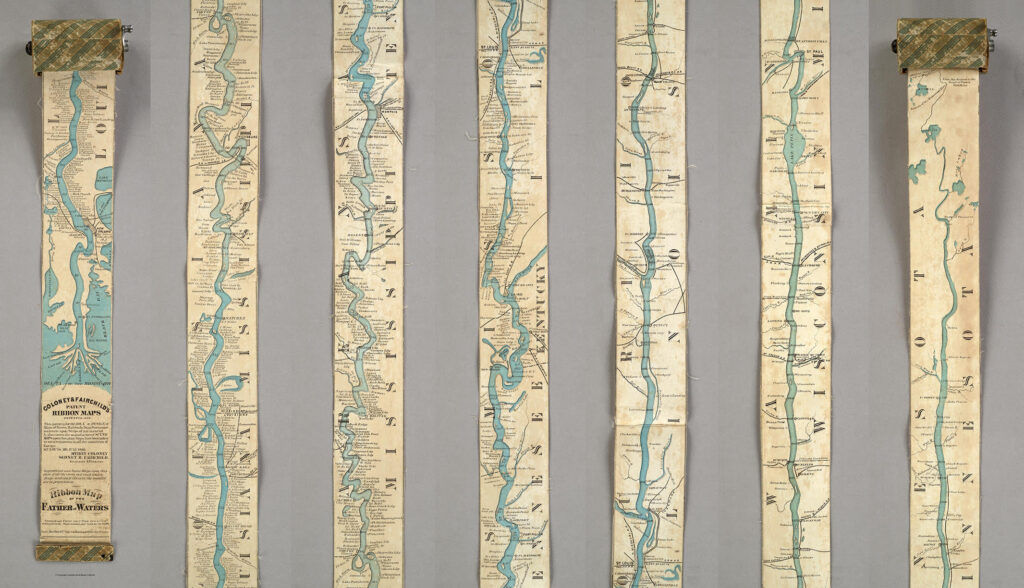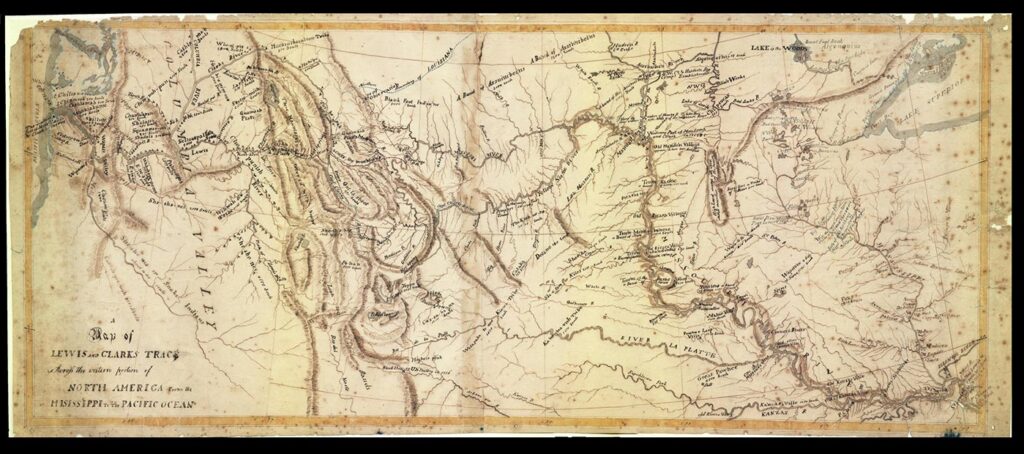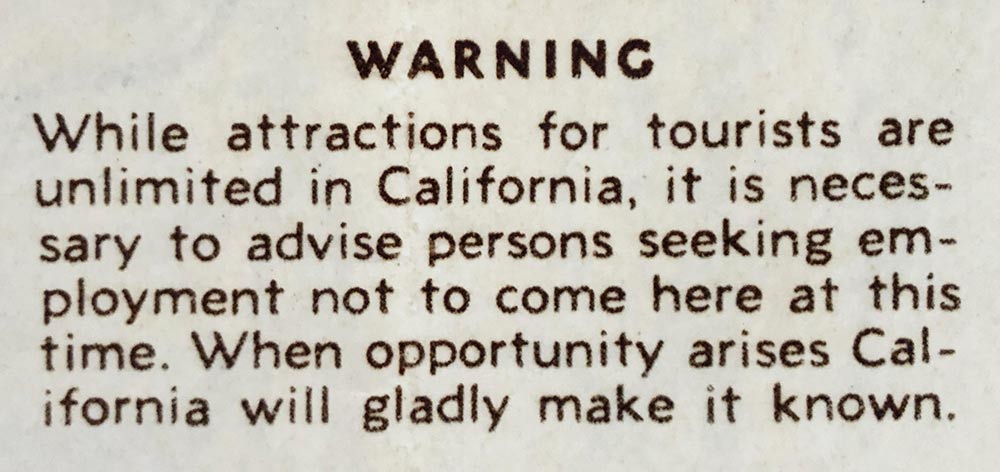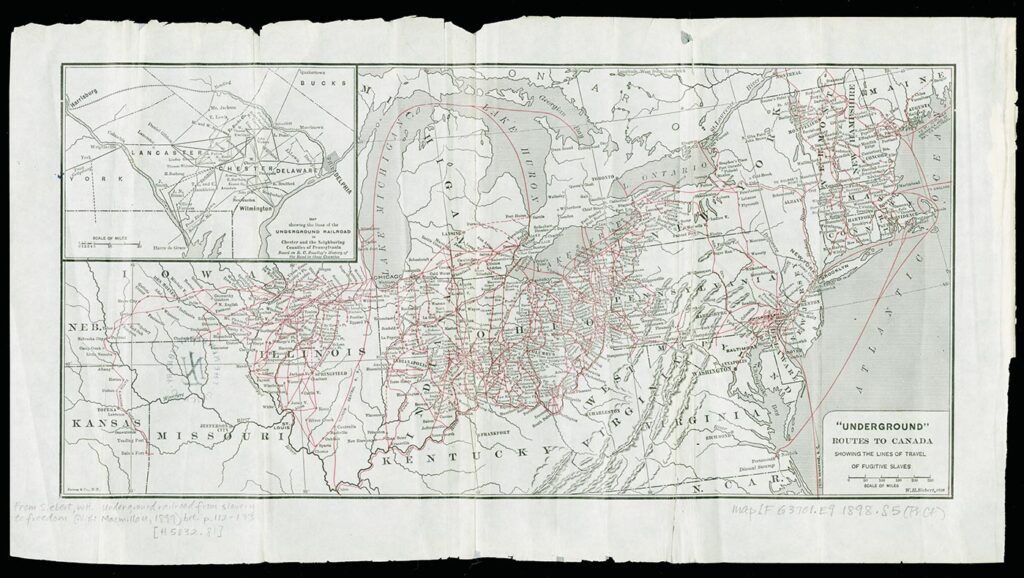How do we cross the United States? Not just by car on a classic road trip or by train in decades past. Not just for pleasure. How do you journey north and south, east and west across the continent if you’re an indigenous person thrown off your land or an escaped slave seeking freedom?
The Newberry Library, the storied research institution in Chicago, delved into its huge collection of historic guidebooks, maps, postcards, diaries, and much more to mount a special exhibition Crossings: Mapping American Journeys. The exhibit presents the ways people have navigated the US, from Lewis and Clark through the first vacationers packing up the Rambler and heading out on a new Interstate freeway in the 1950s.
Beauty, detours, discrimination, natural barriers, and wanderlust are just some of the influences and considerations covered in the extensive exhibits, which will beguile anyone fascinated by the ways we navigate the nation.
The show runs until June 25 at the library on Chicago’s Near North Side, but since we know a lot of our readers won’t make it to Chicago in time, we spoke with Jim Akerman, the Newberry’s curator of the exhibition and the library’s curator of maps, to understand what the exhibit has to teach us about American journeys, both in the past and the one’s coming down the road. It has been lightly edited for clarity.
What’s the genesis for the show? Where did the idea come from and how long ago was that?
I have been researching the history of American travel mapping for about 30 years. I trace the origin of the show with the Newberry’s acquisition of the Rand McNally Company archives around 1990, and similar acquisitions of the archives of the H.M. Gousha Company and the General Drafting Company, which were rivals to Rand McNally in the publication of automobile road maps from the 1920s to the 1980s. I published some articles on the history of road maps and curated an exhibit on road maps in 1996 called Paper Trails: Mapping American Journeys in the Twentieth Century. Among other things, that exhibit probed the relationship between automobile tourism, road maps, and American identity. One entire section dwelt with how maps and travel publications portrayed American history. So I had been thinking about the themes developed in Crossings for a long time.
Over the intervening 25 years, I became interested in American travel mapping during the nineteenth century. The library has fine collections documenting the history of migration and transportation since the American Revolution.
Rand McNally began its map publication history with, among other things, maps, guidebooks, and atlases for railroad companies, travelers, and shippers. I became particularly interested in the development of guides produced for immigrants to the US and internal migrants to the Midwest and Far West. They come in an almost endless variety documenting the geographical expansion of the United States and, by implication, the destruction and displacement of Indigenous communities. These include guides for travelers on the Ohio and Mississippi Rivers and on the Oregon and California Trails; general guides to railroads, canals, and road systems; guides to specific regions, states, and cities for tourists and migrants; and promotional maps and guides published by and for railroad companies. The railroad maps are especially interesting because they adopt a rhetorical approach to promoting their lines and, in the Midwest and West the lands granted them by the federal government. I had written previously about the role of automobile road maps in promoting the development of automobile highways, and I was interested in the same activism adopted by the sponsors of travel maps and guidebooks in the nineteenth century. It seemed to me that they were part of the same story. I wanted to find a way to tell a unified story of travel mapping
More generally, the breadth of the exhibit geographically, chronologically, and thematically allows us to showcase the strength of the Newberry’s map and travel collections, which is something I very much wanted to do.

The exhibit is organized around four broad routes across the US. How did this come about?
I am a geographer, so to start with, I think spatially more than chronologically. It just made sense to me to arrange the material geographically. This allows comparison of maps over time and allowed us to compare the perspectives of immigrants and settlers—say in the northern Great Plains—with the realities of the Native people who were displaced by them. It was very important to me this time around to move beyond tourism to a more inclusive idea of American travel to embrace not only of “voluntary” migration but also enforced migration and displacement and the restrictions on travel imposed on enslaved people.
The title “Crossings” expresses both the durability and salience of certain pathways across the country and the notion that travel can be a passage from one stage of life to another.
How did you finally settle on what to include, as you pondered the vast holdings of the Newberry?
That’s a messy process. There were perhaps 10 to 15 objects that I felt I had to include. The Owens 1936 map of California was one as it shows the state at a time it was a destination for so many. The Lewis and Clark manuscript was another. Beyond those, there were classes of maps I felt needed to be in there and places (like New York City, Chicago, and Los Angeles) that had to be represented somehow. So it comes down to this: from 30 to 50 good candidates for a particular place, which ones tell the story best, which are understandable with little commentary, which are eye-catching, and which are in good shape.

Do you have a particular favorite item on display?
Early on I decided that I wanted to include a couple of large maps representing the view west from the Atlantic seaboard and the view east from the Pacific. One of the advisors to the exhibit advised Aaron Arrowsmith’s map of the United States in 1808, which only shows the country as far as the Mississippi. I wasn’t very familiar with the map, but I was surprised and thrilled when I discovered that the original owner of our copy had drawn in — perhaps around 1825 — canals that had come into existence since the map was published or which were proposed or under construction. It’s a great example of how dynamic the US transportation system was in the early 19th century.
There are several other maps in the exhibit that are annotated, and these are among my favorites. One of these is a guidebook to navigating the Ohio River that was annotated by a tourist from Connecticut about 1815. He noted each day where he stopped. There is a similar item a few feet away that was annotated for a gold prospector going to California in 1852.
Part of the reason I like these items is that I worked so hard to find them. Our catalog doesn’t always indicate whether an item is annotated. Several years ago, while researching a paper on map annotation, I found I had to locate items in our collection by spending many hours in the book stacks going shelf by shelf looking for likely candidates. Tedious, but very rewarding. Geeky too, I guess.
What items will visitors find the most surprising? For me, it was the explicit way that California’s tourism promotion in 1935 told people NOT to head to the state looking for work.
People seem to find that California map you mention very surprising. While people may have read The Grapes of Wrath and about the Dust Bowl, I think it is a shock to some that the rhetoric of this welcoming tourist map would be so explicitly unwelcoming to migrants. And of course, its resonance with the issues today is profound.

A second example would be the pairing of the map of Minnesota and eastern Dakota Territories published in 1863 — in the wake of the US-Dakota War of 1862 — with the map issued by the Northern Pacific Railroad to entice German settlers to the same area barely ten years later. People who have been on tours with me have responded very strongly to that. It shows such profound change in the perceptions of that region in a very short time.
The grid on the earlier map shows the lands that were being surveyed for sale to white colonizers while showing the reservations that Indians had been forcibly removed from. So, though it makes no specific reference to the war, the lines on the map are, in effect, the imprint of the effects of the war — or rather of the larger, longer processes of removal and colonization of which the US–Dakota War was just one (very important) contributing event.
Ten years later, the railroad map shows the territory already being promoted for sale to one group of potential immigrants from Germany. This map barely recognizes the existence of the Indigenous inhabitants of the region, not only in Minnesota but across the entire line of the railroad (still under construction until the 1880s). For example, no Indian reservations are shown on the map, even though many tribes still lived in the region (as they do today).
Though the maps are 10 years apart, I think it is better to think of them not so much as a change in attitude — there was no fundamental change in attitude here — as two slightly different ways in which the process of removal/colonization is represented. One deals directly, and a larger scale with the details of removal for settlement. And one promotes colonization more directly by misleadingly showing the northern plains as a space largely devoid of indigenous people.
A third example is the Go Guide, a guidebook for African-American travelers during a time when prejudice was one of the greatest obstacles to travel in the US. Despite the brief fame of the Green Book, I think a lot of visitors find the Go Guide to be a surprise. It’s one thing for people to be vaguely aware of these types of prejudice, but for people who have not had this experience, it is a bit of a shock to be confronted with a publication that directly responded to the problems of Jim Crow travel. I’d like to think that several of the displays force people to be confronted with these realities.

Can you give me an example of some content inside the Go Guide that may not be seen during the exhibition but which speaks to the experience of the travelers using it. How does it address prejudice in showing its readers where to stay and eat and how to travel safely?
Interestingly, the Go Guide doesn’t explicitly address prejudice. It adopts a more positive approach — just simply listing what is available and providing listings. There are several recent books that deal with the subject of travel in the Jim Crow era that cite personal accounts of the difficulties of travel in the Jim Crow. Of these, the best is Mia Bay’s Traveling Black.
If you were doing this exhibit in 50 years, what’s something relevant to the travel experience now that might be a core part of the exhibition?
Fifty years from now… a good question: In ways we cannot fully comprehend now, but which would be clear by then, the exhibit would probably be dealing with two ongoing events that are changing travel. One is the effect of climate change, which may seriously affect both the attitude towards travel and limit our ability to travel. Second, the limitations on mobility placed on us by Covid may not be temporary. It will be interesting to see whether the evolution of virtual travel may impact our desire to physically travel.
I’d like to think that our historical understanding of Native, African, and Chinese Americans in the story of American travel will have changed, but given recent attempts of politicians in some places to turn back the clock, I’m not confident of that.
Learn more about the special exhibition Crossings: Mapping American Journeys at Chicago’s Newberry Library, on display through June 25, 2022.
